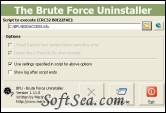|
Brute Force Uninstaller 
|
Brute Force Uninstaller (BFU) is a scripting program that can execute a series of preset commands like a Windows batch file, aimed at uninstalled programs that are hard to remove, uninstall improperly or simply unwanted. There are available options to let the script execution manage files, folders, ini files, Registry keys and values, hosts file content, processes loaded in memory, dll files, NT services and Winsock components. Message boxes can be displayed, the system can be rebooted, the Recycle Bin can be used for delete operations and programs can be started. Options for the script itself include unloading the shell (i.e. killing the Explorer.exe process), pausing between commands (or all commands) and setting a minimum required version number for BFU itself to be able to run the script. BFU itself does not store anything on the system and is uninstalled simply by deleting it.
A script can be activated by either downloading the script file (.bfu) and loading it into BFU by means of the 'select scriptfile' button, OR by downloading it directly into BFU with the 'open script url' button. When using the latter option, the scriptfile will be downloaded by BFU and saved on the system before loading it.
Command syntax
The format of the command is very simple, but has a few notes:
<Command> <arg1>|<arg2>|<arg3>
The <Command> is one of the list below, the amount and format (text, number) of arguments depends on the command.
The pipes (|) between the arguments are needed, as they determine how BFU interprets which argument represents what.
For example, if the SystemRun command is used to launch a program without any parameters but it still needs to be hidden from the user's view (default is 1, show it), the command would be:
SystemRun c:\windows\notepad.exe||0
The second argument is empty, but the third is not. The second pipe must not be omitted, or the 0 would be interpreted as parameter for Notepad and the window would be shown.
Whenever brackets are used in the 'Syntax' lines below, this means any of the items seperated by the pipes between them can be used. The brackets should not be used in scripts. For example, when the syntax for a command is DllRegister c:\file.dll|[0|1], this means either DllRegister c:\file.dll|0 or DllRegister c:\file.dll|1 can be used.
Scripts are plaintext and can be written with Notepad, and the command syntax is very transparent. BFU is very complete and powerful unistaller, has a small memory footprint and -- obviously -- doesn't require installing, but executes itself from a single file.
Writing scripts
The 'open script' dialog filters on *.bfu. A .bfu script file is plaintext, commands are not case-sensitive (though parameters can be, case depending). The order of commands can be anything, but it is recommended to put script options at the top and a system restart at the end. Any lines that do not start with a recognized command are ignored, but for readability comments should be easily recognizable, for example by starting them with a certain character (', #, //, /*, <!--, whatever you like).
The root keys for the Registry commands are abbreviated:
HKCR: HKEY_CLASSES_ROOT
HKCU: HKEY_CURRENT_USER
HKLM: HKEY_LOCAL_MACHINE
HKUS: HKEY_USERS
HKCC: HKEY_CURRENT_CONFIG
HKPD: HKEY_PERFORMANCE_DATA
HKDD: HKEY_DYNAMIC_DATA
Available aliases for system folders are:
%SYSTEMDRIVE% - Drive containing the Windows folder (e.g. 'c:')
%WINDIR% - Windows folder
%SYSDIR% - Windows system folder
%TEMPDIR% - Temporary files folder
%PROGRAMFILES% - Program Files
%DESKTOP% - Desktop
%MYDOCUMENTS% - My Documents
%FAVORITES% - Favorites
%STARTMENU% - Start Menu root
%STARTUP% - Startup folder in Start Menu
%PROGRAMS% - Programs folder in Start Menu
%APPDATA% - Application Data
%QUICKLAUNCH% - QuickLaunch folder in Application Data folder
%ALLUSERSDESKTOP% - All Users (Common) Desktop
%ALLUSERSFAVORITES% - All Users (Common) Favorites
%ALLUSERSSTARTMENU% - All Users (Common) Start Menu
%ALLUSERSSTARTUP% - All Users (Common) Startup folder in Start Menu
%ALLUSERSPROGRAMS% - All Users (Common) Programs folder in Start Menu
%ALLUSERSAPPDATA% - All Users (Common) Application Data
%COMPUTERNAME% - Name of the system
%USERNAME% - Currently logged on username
Additional system aliases such as %USERPROFILE% are also expanded, if they exist on the system.
An option for validating the CRC32 checksum of a script is available that will display the checksum and ask for confirmation. This checksum can be provided with the script (not IN the script of course) on a webpage or as part of the script's filename for example. This can be used to verify the script file was downloaded correctly.
The license of this software is Freeware, you can free download and free use this uninstaller software.
